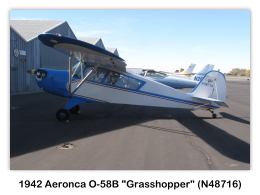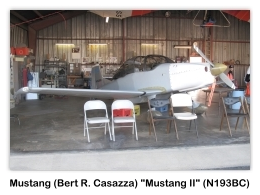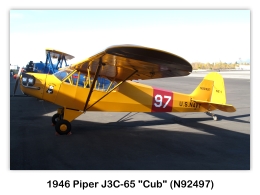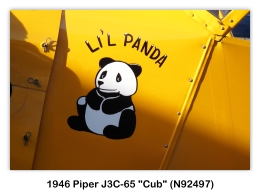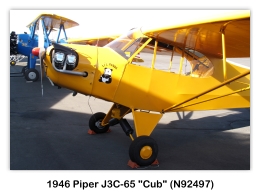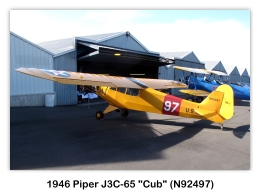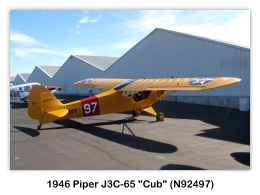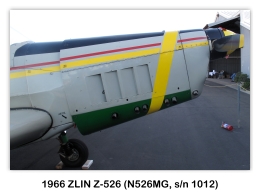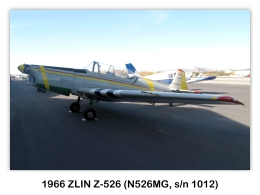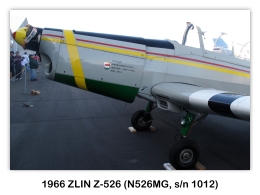


















2009 Cable Air Show — Static Displays ( 3 of 5 )
11 January 2009 (Sunday Air Show)
| Previous | Next |
The Aero Commander 100, various models of which were known as the Darter Commander and Lark Commander was a US light aircraft produced in the 1960s. It was a high-wing monoplane of conventional design, equipped with fixed tricycle undercarriage.
1968 Aero Commander 100 (N269DA, s/n 269)
1969 Aero Commander 100 (N4159X, s/n 341)
The Aeronca L-3 / O-58 group of observation and liaison aircraft were used by the United States Army Air Corps in World War II. The L-3 series were adapted from Aeronca's pre-war Tandem Trainer and Chief models. The L-3 was initially designated the O-58 at the time it was first ordered by the Air Corps. The airplane was given its service tests in the summer of 1941 during maneuvers in Louisiana and Texas where it was used for various support purposes such as a light transport and courier.
1942 Aeronca O-58B "Grasshopper" (N48716, s/n 058B-6452)
Beech Bonanza B36TC "Turbine Air"

The Beechcraft Bonanza is an American general aviation aircraft introduced in 1947 by The Beech Aircraft Corporation of Wichita, Kansas. As of 2009 it is still being produced by Hawker Beechcraft and has been in continuous production longer than any other airplane in history. More than 17,000 Bonanzas of all variants have been built.
199 Beech "Bonanza" B36TC "Turbine Air" (N307M, s/n EA-650)
The Stearman (Boeing) Model 75 is a biplane, of which at least 9,783 were built in the United States during the 1930s and 1940s as a military trainer aircraft. Stearman became a subsidiary of Boeing in 1934. Widely known as the Stearman, Boeing Stearman or Kaydet, it served as a Primary trainer for the USAAF, as a basic trainer for the USN (as the NS & N2S), and with the RCAF as the Kaydet throughout World War II. After the conflict was over, thousands of surplus aircraft were sold on the civil market. In the immediate post-war years they became popular as crop dusters and as sports planes.
1941 Boeing-Stearman B75N1 (NC68800, s/n 75-1694)
2007 Mustang Aeronautics "Mustang II"

The Mustang Aeronautics "Mustang II" is a high performance side-by-side seating aircraft designed for both sport and cross country flying. It is unmatched in speed for the dollar and ease of construction. It features a tapered wing, helping to make it a solid cross country airplane capable of high and long IFR flights.
2007 Casazza "Mustang II" (Burt R. Cassazza) (N193BC, s/n M-II 193)
During 1977 Cessna introduced a new two-seat cabin monoplane to replace the Model 150, which had been in production for almost 20 years. Designated Model 152, it differs primarily in having a more powerful engine, using low-lead 100 octane fuel, an improved 'gull wing' propeller, and power plant installation and cowling changes to reduce engine noise and vibration.
1978 Cessna 152 (N67282, s/n 15281722)
The Cessna 170 is a light, single-engine, general aviation aircraft produced by the Cessna Aircraft Company between 1948 and 1956. In late 1948 Cessna began sales of the 170, with metal fuselage and tail and fabric covered wings. These earliest 170s were four-seat versions of the popular 140 with a more powerful 145 hp (108 kW) Continental O-300 and larger fuel tanks. Like the 140, they were constructed of metal with fabric-covered wings supported by a "V" strut.
1950 Cessna 170A (N170RS, s/n 19611)
The Cessna 177 Cardinal is a light, high-wing general aviation aircraft that was intended to replace Cessna's 172 Skyhawk. First announced in 1967, it was produced from 1968 to 1978. The Cessna 177 was designed in the mid-1960s when the engineers at Cessna were asked to create a "futuristic 1970s successor to the Cessna 172". The resulting aircraft featured newer technology such as a cantilever wing with a laminar flow airfoil. The Cessna 177 is the only production high-wing single-engine Cessna since the Cessna 190/195 series to have both fixed landing gear and a cantilever wing without strut bracing.
1977 Cessna 177B Cardinal (N20124, s/n 17702631)
1943 Douglas C-53D-DO "Skytrooper" (D-Day Doll)

The Douglas aircraft Company at Santa Monica, California developed the C-53 "Skytrooper" from its famous DC-3 airliner at the request of the Army Air Corps to fill the need for a paratroop carrier. A total of 403 C-53's were built of all versions. The C-53D-DO "Skytrooper" shown below s/n AF 42-68830, was one of 159 "D" models and came off the assembly line on July 6, 1943. This aircraft is stationed at the Riverside municipal Airport, and operated by the Commemorative Air Force Inland Empire Wing.
1943 Douglas C-53D-DO "Skytrooper—D-Day Doll" (N45366, AF 42-68830, c/n 11757)
1986 Fokker S-11-1 "Instructor"

The Fokker S-11 "Instructor" is a single engine two seater propeller aircraft designed and manufactured by the former Dutch aircraft manufacturer Fokker.
1986 Fokker S-11-1 "Instructor" (N911J, s/n E-11)
The Globe Swift (also known as the Globe/Temco Swift), first advertised as the "All Metal Swift", was a light, two-seat sport monoplane of the post-World War II period. Designed by R.S. "Pop" Johnson in 1940, the fanciful story of a Culver Cadet obtained as a "template" aircraft has now entered into popular mythology surrounding the aircraft's origins. The design was secured by John Kennedy, president of the Globe Medicine Company, to be built by his new Globe Aircraft Company. World War II interrupted their plans, however, and the 85 hp GC-1A Swift advertised as the "All Metal Swift" re-designed by K.H."Bud" Knox, received its type certificate on 7 May 1946. Two prototypes were built but essentially, the design remained the same as the type entered production. Globe built about 408 GC-1As.
1946 Globe GC-1B "Swift" (N3214K, s/n 1207)
The Kinner Sportster was a 1930s American light monoplane built by Kinner Airplane & Motor Corporation.
1934 Kinner "Sportster K" (NC14218, s/n 136)
North American P-51D "Mustang"

The North American Aviation P-51 Mustang was a long-range single-seat World War II fighter aircraft. Designed, built and airborne in just 117 days, the Mustang first flew in RAF service as a fighter-bomber and reconnaissance aircraft before conversion to a bomber escort, employed in raids over Germany, helping ensure Allied air superiority from early 1944. The P-51 was in service with Allied air forces in Europe and also saw limited service against the Japanese in the Pacific War. The Mustang began the Korean War as the United Nations' main fighter, but was relegated to a ground attack role when superseded by jet fighters early in the conflict. Nevertheless, it remained in service with some air forces until the early 1980s.
North American P-51D-25-NT "Mustang — Su Su" (N514NH, AF 44-84850)
The Piper J-3 Cub is a small, simple, light aircraft that was built between 1937 and 1947 by Piper Aircraft. With tandem (fore and aft) seating, it was intended for flight training but became one of the most popular and best-known light aircraft of all time. The Cub's simplicity, affordability and popularity invokes comparisons to the Ford Model T automobile. The Cub's standard yellow paint has come to be known as "Cub Yellow."
1946 Piper J3C-65 "Cub — L'Il Panda" (N92497, s/n 16921)
Piper PA-28-140 "Cherokee 140"

The Piper PA-28-140 Cherokee is a member of a family of light aircraft designed for flight training, air taxi and personal use, built by Piper Aircraft. All members of the PA-28 family are all-metal, unpressurized, four-seat, single-engine piston-powered airplanes with low-mounted wings and tricycle landing gear. All PA-28 aircraft have a single door on the co-pilot side, which is entered by stepping on the wing. The first PA-28 received its type certificate from the FAA in 1960 and the series remains in production in 2009. Current models are the Arrow and Warrior III. The Archer was discontinued in 2009, but will be revived in 2010.
1968 Piper PA-28-140 "Cherokee 140" (N6794J, s/n 28-24533)
The Piper Aerostar or Ted Smith Aerostar is an American twin-engine propeller-driven executive or light transport aircraft, designed by Ted R. Smith. It was originally built by Ted Smith Aircraft Company, which after 1978 became part of the Piper Aircraft Corporation.
1977 Piper "Aerostar 601P" (N11TT, s/n 61P-0394-134)
Porterfield CP-65 "Collegiate"

The Porterfield Collegiate was an American two-seat training monoplane built by the Porterfield Aircraft Corporation of Kansas City. Developed originally as the Porterfield "Zephyr" a light-weight version of the earlier Model 35 "Flyabout" for use a pilot trainer. Powered by a 40-hp (30kW) Continental A-40 engine it was later re-designated the Porterfield CP-40. To improve performance the engine was replaced with a 50-hp (47kW) Continental A50-4 engine and re-designated the CP-50 Collegiate. It was a braced high-wing monoplane with a tailskid fixed landing gear. Total production was about 400 when production stopped in 1941 at the start of American involvement in the Second World War. A number of variants were produced with different engine installations.
1941 Porterfield CP-65 "Collegiate" (NC37895, s/n 1025)
The Stinson L-5 "Sentinel" began life as the pre-war Stinson model 105. The model 105 was nicknamed "Voyager" and was built by the Stinson division of Consolidated Vultee. When World War II broke out, the Voyager was redesigned and then entered into service as a liaison aircraft. It also flew in the artillery spotter role and as an air ambulance. The later model Stinson L-5 Sentinels had their fuselages modified to accommodate one stretcher patient. The Stinson L-5 Sentinels were manufactured between October 1942 and September 1945. During this time a total of over 3,896 of these unarmed, two-seat aircraft were built for the United States armed forces, making it the second most widely used light observation aircraft of the war. Personnel in all service branches commonly referred to it as the "Flying Jeep".
1944 Stinson L-5B "Sentinel — Porchdog" (N5607V, s/n 2946)
The Taylorcraft B is a light, side-by-side two place, single engine, high wing general aviation monoplane that was built by the Taylorcraft Aviation Corporation of Alliance, Ohio. The aircraft was available as a land plane and a floatplane.
1939 Taylorcraft BL-65 (N23844, s/n 1480)
The Waco F series was a range of American-built private pilot owner and training biplanes of the 1930s from the Waco Aircraft Company.
1940 Waco UPF-7 "Lil Passion" (NC29338, s/n 5365)
The Zlin Z-526 is a Czech built aircraft that was originally designed by Zlin Aircraft in 1959. Its two seat version is called the Trener-Master. The Zlin Z-526's layout was organized with pilot in the rear, and student in front. The aircraft could also be equipped with tip tanks and a constant speed propeller.
1966 ZLIN Z-526 (N526MG, s/n 1012)
| Home
| Archive Subscriber Support
| Guestbook
| Contact Us
| Legal Notice
| Aviation Links
|
Copyright © 2010 Skytamer Images, Whittier, California
ALL RIGHTS RESERVED







